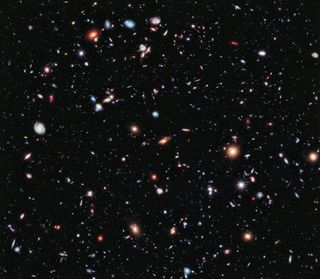Hubble Telescope Reveals Farthest View Into Universe Ever

The Hubble Space Telescope has captured the farthest-ever view into the universe, a photo that reveals thousands of galaxies billions of light-years away.
The picture, called eXtreme Deep Field, or XDF, combines 10 years of Hubble telescope views of one patch of sky. Only the accumulated light gathered over so many observation sessions can reveal such distant objects, some of which are one ten-billionth the brightness that the human eye can see.
The photo is a sequel to the original "Hubble Ultra Deep Field," a picture the Hubble Space Telescope took in 2003 and 2004 that collected light over many hours to reveal thousands of distant galaxies in what was the deepest view of the universe so far. The XDF goes even farther, peering back 13.2 billion years into the universe's past. The universe is thought to be about 13.7 billion years old.

"The XDF is the deepest image of the sky ever obtained and reveals the faintest and most distant galaxies ever seen," Garth Illingworth of the University of California at Santa Cruz, principal investigator of the Hubble Ultra Deep Field 2009 program, said in a statement. "XDF allows us to explore further back in time than ever before."
The photo reveals a wide range of galaxies, from spirals that are Milky Way-lookalikes, to hazy reddish blobs that are the result of collisions between galaxies. Some of the very tiny, faint galaxies could be the seeds from which the biggest galaxies around today grew. [Most Amazing Hubble Discoveries]
The XDF is a portrait of a small area of space in the southern constellation Fornax, and spans only a small fraction of the area of the full moon. Within that region, Hubble has revealed 5,500 galaxies, many of which existed shortly after the birth of the universe.

The farthest-away galaxies are 13.2 billion light-years from Earth, meaning their light has taken 13.2 billion years to travel to Hubble's cameras.
Get the Space.com Newsletter
Breaking space news, the latest updates on rocket launches, skywatching events and more!
"The light from those past events is just arriving at Earth now, and so the XDF is a 'time tunnel into the distant past,'" according to a NASA statement. "The youngest galaxy found in the XDF existed just 450 million years after the universe's birth in the Big Bang."
Hubble was only able to image these objects by amassing light in 2,000 images of the same area, with a total exposure time of 2 million seconds, through two of its cameras: the Advanced Camera for Surveys and the Wide Field Camera 3.
Hubble was launched in April 1990, and has been visited by space shuttle crews five times since then for upgrades. The telescope, a collaboration between NASA and the European Space Agency, is still going strong, and scientists say the scope should be able to function through at least 2018.
Follow SPACE.com on Twitter @Spacedotcom. We're also on Facebook & Google+.
Join our Space Forums to keep talking space on the latest missions, night sky and more! And if you have a news tip, correction or comment, let us know at: community@space.com.

Clara Moskowitz is a science and space writer who joined the Space.com team in 2008 and served as Assistant Managing Editor from 2011 to 2013. Clara has a bachelor's degree in astronomy and physics from Wesleyan University, and a graduate certificate in science writing from the University of California, Santa Cruz. She covers everything from astronomy to human spaceflight and once aced a NASTAR suborbital spaceflight training program for space missions. Clara is currently Associate Editor of Scientific American. To see her latest project is, follow Clara on Twitter.
